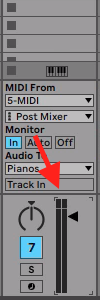Having a great set up and excellent patches are only step one of playing great live keyboard. We must also have an excellent Keyboard mix.
As I see it, in a live context there are three tools we can use to help up get a great keyboard mix.
- Patch Volume
- EQ
- Category Bus Control
Patch Volume
As simple as it is, getting all of your patches at the same volume is step number one.
If you are using a dynamic patch list, this can be done by using the channel fader. But so long as you are adjusting the sounds one by one to get them to the right level in an isolated way, you are in business.

Adjusting the volume in this manner helps your sounds to start to sit together better. Sometimes a synth lead sound is too loud in the context of all your other patches. When this is the case and you are playing some softer sounds and you bring in that synth, it will be extrememly frightening, and could potentially hurt your ears! You don’t want any of that.
EQ
Eq is really just a fancier volume control. Rather than turning up the whole sound, it allows you to turn up and down only certain frequencies.
Using EQ takes sounds that are all sitting in a similar area of the audio spectrum, and allows them to all have enough space to be heard.
Some General EQ Rules of Thumb
- Many patches have a lot of information in the lower register.
- Unless your patch is meant to be a bass sound, it is generally safe to use either a high pass filter or a low shelf to pull those frequencies a little bit lower.
- You can make use of the “little blue headphones” (Pictured below) to locate parts of the sound that might be a little garbled or have a “wah” like quality to it.
- While those parts of the sound wouldn’t be bad on their own, they are taking up space that could be occupied by another patch, or by a sound that is pleasing to the ear.
- It is generally better to take away, rather than to add
- Removing sound from one area, will, in turn, increase the volume of another
- The one exception being it is common to use a high shelf to add a little extra “shine” to a sound
- Removing sound from one area, will, in turn, increase the volume of another

Make sure you take some time to go through each patch and EQ. It is best to EQ in context, so layer some sounds together that you often play at the same time, and go to town.
Category Bus Control
This is the secret sauce of getting a great keyboard mix.
Things happen when you are playing live. Your guitarist goes rogue and turns up to 11, the number of people in the room changes, the sound guy gets distracted by Instagram. You never know.
But after soundcheck, and depending on where a song takes you, you may need to be able to adjust levels.
This is a concept I explore deeply in Practical Sound Design For Keyboardists.
You must have the ability to change at the very least, volume, and timbre at any given point on any given patch.
This is impossible if you are working with a large number of sounds, but by making use of a patch bus, you are able to manipulate all sounds in a given category spontaneously.
This is the last layer because it means that in addition to having your sounds balanced and EQed you can adjust your levels slightly throughout your live set.
Moving Forward
Make sure you are plugged into the Livekeyboardist community by grabbing a copy of the The Quick Synth map. This is a great tool to help you navigate your way around synthesizers.
In addition to this, you can connect with me personally at any time through the LiveKeyboardist Facebook community, or through my contact page.
